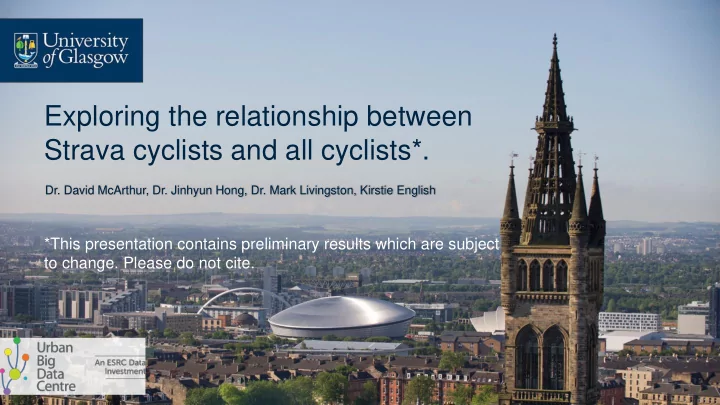

Exploring the relationship between Strava cyclists and all cyclists*. Dr. David McArthur, Dr. Jinhyun Hong, Dr. Mark Livingston, Kirstie English *This presentation contains preliminary results which are subject to change. Please do not cite.
Active travel • Walking and cycling can generate large benefits • Reduced congestion • Reduced emissions • Improve health • Time savings • Transport Scotland wants 10% of journeys to be made by bicycle by 2020; with cities responsible for achieving this
Do interventions work? • Evaluating the effectiveness of interventions is difficult due to the lack of data • Manual counts take place on specific links/points, but these are expensive and hence infrequent • Automatic counters can be used but these are also expensive and tend to be sparsely located • Maintenance and calibration is required to keep them working properly
New data • Activity tracking apps are used by many people and provide valuable new data about activities • The Strava cycling app uses GPS to track cyclists’ journeys • This offers the possibility of having data at a fine spatial and temporal scale for a large number of people • The data are already being collected all over the world
• The name is taken from the Swedish word sträva, meaning to strive • It can be used to track running and cycling activities • Users can track their activities over time and compare to the activities of their friends or the user community • Users can also compete in competitions • The app comes in a free and premium version. The premium version offers extra features and costs £5.99 a month or £49.99 per year
• Users have to start and stop the tracking • They can tag whether or not their trip is a commute or not • Strava also gather some demographic information about their users
Data • The movement data collected by the app is raw GPS trajectories represented as a triple (latitude, longitude, timestamp)
Data • The GPS trajectories are not made available to researchers • The data is aggregated and provided to researchers/planners through Strava Metro • Data are provided as: • Origins and destinations with route information (at output area level) • Minute-by-minute link counts of cycling flows • Information about waiting times at junctions • Aggregate demographic information
Problems • We know not all cyclists use the app for every journey • It is unlikely that a random sample of cyclists use the Strava app • In Glasgow in 2015 there were 13,684 athletes who recorded 287,833 activities • The median distance was 14.9 km • Of this sample 11,216 were male (1,698 female) • Can the sample tell us anything useful?
Our approach • Firstly, we can visualise the data and do a basic sanity check; the patterns look like what we would expect given our knowledge of Glasgow • We can compare it to other sources of data • We use the annual two-day cordon counts which are conducted in Glasgow city centre • We match the links where the counts take place to the same link in the Strava data
Cordon Count (CC) • Cycle trips are counted in blocks of 30 minutes for 14 hours over two days in September each year • We use data from 2013, 2014 and 2015 • We aggregate both the CC and the Strava data into four different temporal scales, specifically by: • Hour • Commuting time (peak hours versus non-peak) • Day • Two-day (i.e. annual)
Correlations Sample size Correlation Hourly 3192 0.781 Peak Vs Non-peak 684 0.861 One day 228 0.882 Two days 114 0.887
Further work • We have some additional hypothesis about how these correlations my vary: • Does Strava have a higher market share in rich areas e.g. the West End of Glasgow? • Is the market share of Strava changing over time? • Does the weather affect the percentage of cyclists using Strava? • Does the time of day affect the share of cyclists using Strava?
Models • We have experimented with negative binomial regression models • The number of total cyclists is modelled as a function of, among other things, the number of Strava cyclists • This allows us to explore the factors influencing the link between the cycling flows • It also allows us to adjust the Strava flows to an estimate of total flows across the network
Independent Model 1 Model 2 Model 3 Model 4 Coeffecient P= Coeffecient P= Coeffecient P= Coeffecient P= Strava 0.084 0.000*** 0.265 0.000*** 0.098 0.000*** 0.105 0.000*** Commuting (ref non-commuting) AM 0.317 0.001*** 0.506 0.000*** 0.305 0.001*** 0.177 0.055 PM 0.553 0.000*** 0.823 0.000*** 0.542 0.000*** 0.449 0.000*** Year (ref:2013) 0.162 0.077 0.154 0.086 0.147 0.140 0.125 0.162 Year (2014) 0.046* 0.619 0.001 0.989 0.141 0.152 0.007 0.938 Year (2015) Region (ref:east) 0.074 0.468 0.083 0.409 0.083 0.419 -0.099 0.387 North 0.318 0.002 0.361 0.000*** 0.320 0.002** 0.149 0.194 South 0.731 0.000 0.695 0.000*** 0.742 0.000*** 0.927 0.000*** West Interactions -0.181 0.000*** Strava*am -0.200 0.000*** Strava*pm 0.001 0.946 Strava*2014 -0.030 0.013* Strava*2015 0.102 0.001** Strava*North 0.037 0.033 Strava*South -0.057 0.000*** Strava*West Intercept (con) 3.057 0.000 2.882 0.000*** 3.028 0.000 3.099 0.000*** Dispersion 1.074 1.120 1.081 1.141
Conclusions • Strava shows good correlation with observed cycle counts • Your body text should be min font • The correlation is higher the more we aggregate the size 16 and we recommend that you use the images we have provided observations • These correlations change depending on different • We recommend that you use headings or bullet points factors • This seems to correspond with what has been found in • Your audience want to hear and see you present not read from a the literature slide.
Thank you for your attention. The data used are available from the Urban Big Data Centre @UofGlasgow
Recommend
More recommend